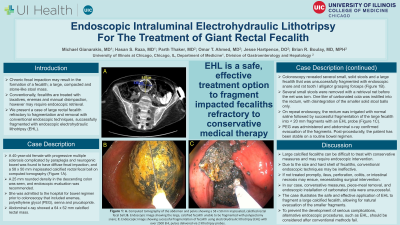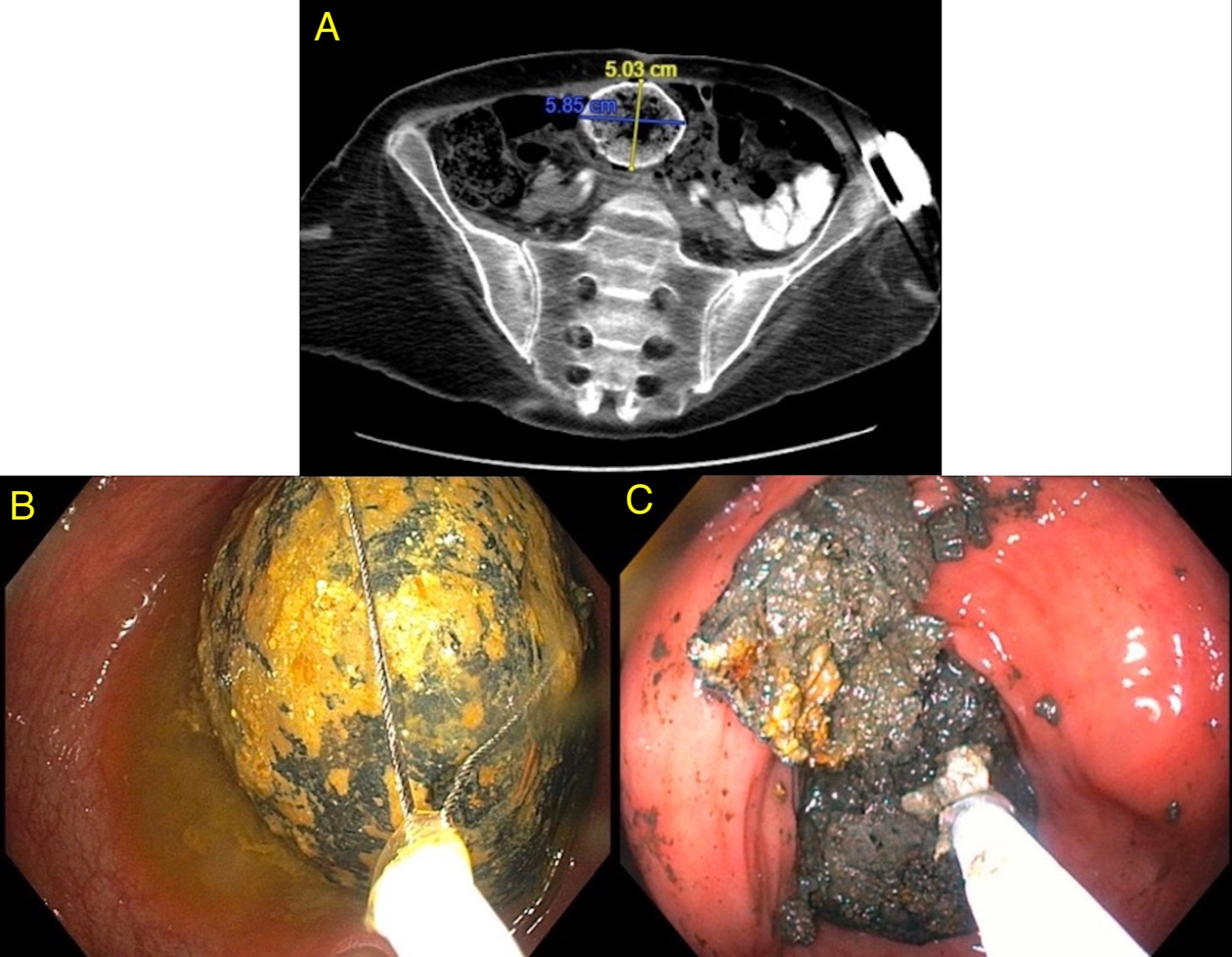Tuesday Poster Session
Category: Interventional Endoscopy
P4559 - Endoscopic Intraluminal Electrohydraulic Lithotripsy for the Treatment of a Giant Rectal Fecalith
Tuesday, October 29, 2024
10:30 AM - 4:00 PM ET
Location: Exhibit Hall E

Has Audio

Michael Gianarakis, MD
University of Illinois at Chicago
Chicago, IL
Presenting Author(s)
Award: Presidential Poster Award
Michael Gianarakis, MD1, Hasan S. Raza, MD2, Parth Thaker, MD2, Omar T. Ahmed, MD1, Jesse Hartpence, DO1, Brian R. Boulay, MD, MPH2
1University of Illinois at Chicago, Chicago, IL; 2University of Illinois, Chicago, IL
Introduction: Chronic fecal impaction may result in the formation of a fecalith; a large, compacted and stone-like stool mass. Conventionally, fecaliths are treated with laxatives, enemas and manual disimpaction, however may require endoscopic retrieval. Herein, we present a case of large rectal fecalith refractory to fragmentation and removal with conventional endoscopic techniques, successfully fragmented with endoscopic electrohydraulic lithotripsy (EHL).
Case Description/Methods: A 40-year-old female with progressive multiple sclerosis complicated by paraplegia and neurogenic bowel was found to have diffuse fecal impaction, and a 58 x 50 mm inspissated calcified rectal fecal ball on computed tomography (Figure 1A). A 25 mm rounded density in the descending colon was seen, and endoscopic evaluation was recommended. She was admitted to the hospital for bowel regimen prior to colonoscopy that included enemas, polyethylene glycol (PEG), senna and prucalopride. Abdominal x-ray showed a 64 x 52 mm calcified rectal mass.
Colonoscopy revealed several small, solid stools and a large fecalith that was unsuccessfully fragmented with endoscopic snare and rat tooth / alligator grasping forceps (Figure 1B). Several small stools were removed with a retrieval net before the net was torn. One liter of carbonated cola was instilled into the rectum, with disintegration of the smaller solid stool balls only. On repeat endoscopy, the rectum was irrigated with normal saline followed by successful fragmentation of the large fecalith into < 20 mm fragments with an EHL probe (Figure 1C). PEG was administered and abdominal x-ray confirmed evacuation of the fragments. Post-procedurally, the patient has been stable on a routine bowel regimen.
Discussion: Large calcified fecaliths can be difficult to treat with conservative measures and may require endoscopic intervention. Due to the size and hard shell of fecaliths, conventional endoscopic techniques may be ineffective. If not treated promptly, ileus, perforation, colitis, or intestinal necrosis may ensue, necessitating surgical intervention. In our case, conversative measures, piece-meal removal, and endoscopic installation of carbonated cola were unsuccessful. The case illustrates the safe and effective application of EHL to fragment a large calcified fecalith, allowing for natural evacuation of the smaller fragments. To prevent the development of serious complications, alternative endoscopic procedures, such as EHL, should be considered after conventional methods fail.

Disclosures:
Michael Gianarakis, MD1, Hasan S. Raza, MD2, Parth Thaker, MD2, Omar T. Ahmed, MD1, Jesse Hartpence, DO1, Brian R. Boulay, MD, MPH2. P4559 - Endoscopic Intraluminal Electrohydraulic Lithotripsy for the Treatment of a Giant Rectal Fecalith, ACG 2024 Annual Scientific Meeting Abstracts. Philadelphia, PA: American College of Gastroenterology.
Michael Gianarakis, MD1, Hasan S. Raza, MD2, Parth Thaker, MD2, Omar T. Ahmed, MD1, Jesse Hartpence, DO1, Brian R. Boulay, MD, MPH2
1University of Illinois at Chicago, Chicago, IL; 2University of Illinois, Chicago, IL
Introduction: Chronic fecal impaction may result in the formation of a fecalith; a large, compacted and stone-like stool mass. Conventionally, fecaliths are treated with laxatives, enemas and manual disimpaction, however may require endoscopic retrieval. Herein, we present a case of large rectal fecalith refractory to fragmentation and removal with conventional endoscopic techniques, successfully fragmented with endoscopic electrohydraulic lithotripsy (EHL).
Case Description/Methods: A 40-year-old female with progressive multiple sclerosis complicated by paraplegia and neurogenic bowel was found to have diffuse fecal impaction, and a 58 x 50 mm inspissated calcified rectal fecal ball on computed tomography (Figure 1A). A 25 mm rounded density in the descending colon was seen, and endoscopic evaluation was recommended. She was admitted to the hospital for bowel regimen prior to colonoscopy that included enemas, polyethylene glycol (PEG), senna and prucalopride. Abdominal x-ray showed a 64 x 52 mm calcified rectal mass.
Colonoscopy revealed several small, solid stools and a large fecalith that was unsuccessfully fragmented with endoscopic snare and rat tooth / alligator grasping forceps (Figure 1B). Several small stools were removed with a retrieval net before the net was torn. One liter of carbonated cola was instilled into the rectum, with disintegration of the smaller solid stool balls only. On repeat endoscopy, the rectum was irrigated with normal saline followed by successful fragmentation of the large fecalith into < 20 mm fragments with an EHL probe (Figure 1C). PEG was administered and abdominal x-ray confirmed evacuation of the fragments. Post-procedurally, the patient has been stable on a routine bowel regimen.
Discussion: Large calcified fecaliths can be difficult to treat with conservative measures and may require endoscopic intervention. Due to the size and hard shell of fecaliths, conventional endoscopic techniques may be ineffective. If not treated promptly, ileus, perforation, colitis, or intestinal necrosis may ensue, necessitating surgical intervention. In our case, conversative measures, piece-meal removal, and endoscopic installation of carbonated cola were unsuccessful. The case illustrates the safe and effective application of EHL to fragment a large calcified fecalith, allowing for natural evacuation of the smaller fragments. To prevent the development of serious complications, alternative endoscopic procedures, such as EHL, should be considered after conventional methods fail.

Figure: Figure 1: A. Computed tomography of the abdomen and pelvis showing a 58 x 50 mm inspissated, calcified rectal fecal ball; B. Endoscopic image showing the large, calcified fecalith unable to be fragmented with polypectomy snare; C. Endoscopic image showing successful fragmentation of fecalith using electrohydraulic lithrotripsy (EHL) with over 2500 EHL pulses delivered via 2 lithotripsy probes.
Disclosures:
Michael Gianarakis indicated no relevant financial relationships.
Hasan Raza indicated no relevant financial relationships.
Parth Thaker indicated no relevant financial relationships.
Omar Ahmed indicated no relevant financial relationships.
Jesse Hartpence indicated no relevant financial relationships.
Brian Boulay indicated no relevant financial relationships.
Michael Gianarakis, MD1, Hasan S. Raza, MD2, Parth Thaker, MD2, Omar T. Ahmed, MD1, Jesse Hartpence, DO1, Brian R. Boulay, MD, MPH2. P4559 - Endoscopic Intraluminal Electrohydraulic Lithotripsy for the Treatment of a Giant Rectal Fecalith, ACG 2024 Annual Scientific Meeting Abstracts. Philadelphia, PA: American College of Gastroenterology.

